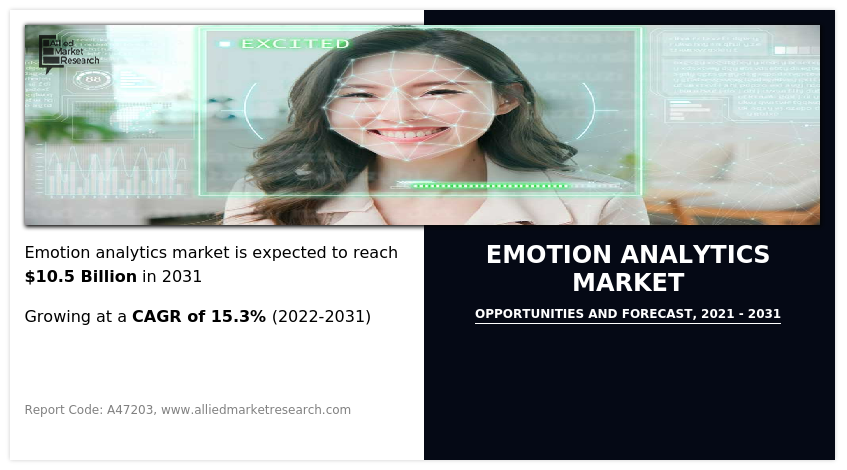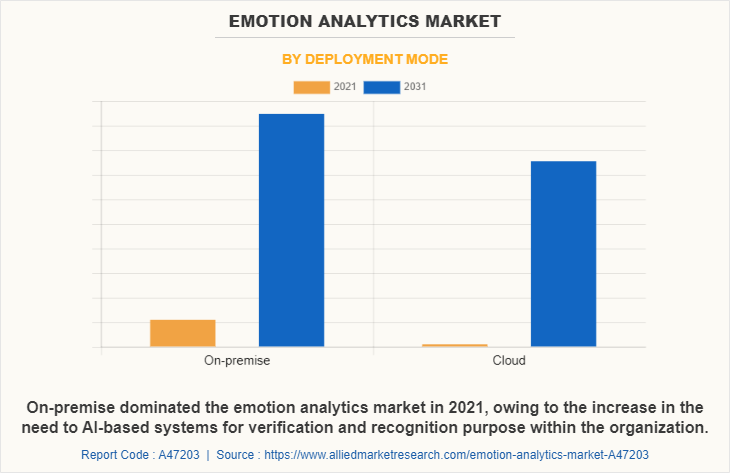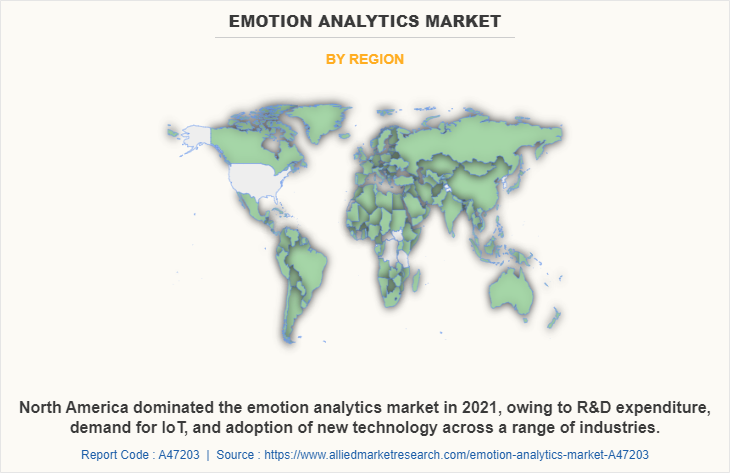Emotion Analytics Market Statistics, 2031
The global emotion analytics market was valued at $2.6 billion in 2021, and is projected to reach $10.5 billion by 2031, growing at a CAGR of 15.3% from 2022 to 2031.
Surge increase in demand from the automotive sector and surge in need for customer behavior management using data primarily drive the emotion analytics market growth. However, analysis of emotional misunderstandings hamper the market growth to some extent. Moreover, applications for emotional recognition are in greater demand and are expected to provide lucrative opportunities for the market growth during the forecast period.

Software for emotion analytics (EA) gathers information on verbal and nonverbal cues to determine a person's mood or attitude. The technology, which is also known as emotional analytics, offers perceptions into how a customer views a product, the way a product is presented, or their interactions with a customer support agent. Large amounts of labelled emotion data are required for the development of emotions analytics software.
For instance, microphones that record voice tones and video cameras that record face expressions both contribute to the collection of emotion data. Machine learning algorithms are taught to distinguish expressions, tones, and other traits that are associated with particular emotions using this data as input. Emotions are often categorized by today's emotion detection technologies as either anger, contempt, bewilderment, disgust, fear, frustration, joy, sadness, or surprise. Emotion detection software has become increasingly important in call centers, sales, and marketing divisions to understand client feelings. Marketing and sales teams can gain a comprehensive understanding of their customers by combining sentiment analysis with their existing CRM data to create tailored advertising campaigns. This is expected to support the growth of the emotion analytics market. The emotion analytics market is segmented into Type, Enterprise Size, Deployment Mode, Application and End User.
The emotion analytics market is segmented on the basis of type, enterprise size, deployment mode, application, end user, and region. On the basis of type, it is segregated into text analytics, facial analytics, speech analytics, and video analytics. On the basis of enterprise size market is segregated into large enterprise and SME’s. On the basis of deployment mode market is segregated into on-premise and cloud. On the basis of application market is segregated into sales and marketing management, customer experience management, competitive intelligence, public safety and law enforcement, and workforce management. On the basis of end users the market is segregated into BFSI, IT and telecom, retail, government, defense and security, and others. Furthermore, on the basis of region the market is segregated into North America, Europe, Asia Pacific, and LAMEA.
The emotion analytics industry is dominated by key players such as HCL technologies, Hexagon ab, Honeywell International, Inc., IBM corporation, Intelex, INX Software, Microsoft Corporation, Vector Solution, and Wolters KLuwer. These players have adopted various strategies to increase their market penetration and strengthen their position in the emotion analytics industry.

Depending on deployment mode, the on-premise segment dominated the emotion analytics market share in 2021, and is expected to maintain its dominance in the upcoming years, owing to increase in the need of AI based systems for verification and recognition purpose within the organization. However, the cloud segment is anticipated to experience the highest growth, owing to the increase in adoption of AI, facial recognition, and other cloud-based software and tools for a variety of applications such as analyzing customer preferences, identifying human emotions, and others.

Region-wise, the emotion analytics market size was dominated by North America in 2021 and is expected to retain its position during the forecast period, owing to R&D expenditure and adoption of new technology across a range of industries aiding the growth of the emotion analytics market. However, Asia Pacific is expected to witness significant growth during the forecast period, owing to fastest-growing economies, high levels of technology penetration in the region which is expected to fuel the market growth in this region. Furthermore, several major emotion analytics solution providers including Adoreboard, Affectiva, Apple, Inc., IBM Corporation, iMotions A/S, Microsoft Corporation, NVISO SA, are introducing new products & services to emotion analytics.
Top Impacting Factors -
Increase in demand from the automotive sector
The automobile industry’s rising demand for emotion analytics supports the market expansion during the projected period. The car industry is transitioning to next generation technologies by adding AI-based solution into vehicles. Automakers spend a lot of money on research and development to make it possible for cars to recognize and respond properly to the emotions expressed by the driver, the application lessens the chance of road accidents by evaluating the driver’s attentiveness and enables gesture, eye movement and touch identification.
Sure in need for customer behavior management using data
One of the key elements fueling the market foe emotion analytics is the increased need for emotion analysis caused by better customer management across sector and industries. With the use of emotion analytics, brands can engage with consumers on a personal and emotional level. Businesses and brands want to know more about their customers as company engage and interact with them through the expanding usage of social media and other digital platforms, so enterprise can provide tailored experiences and goods.
Technological Trends
Technology based on emotion analytics promises to generate exciting new sorts of data, which will eventually be need to understand and improve. The actual test of emotion monitoring and emotion marketing will be in how insights are drawn and used, just like with all of the data-informed marketing advancements that have come before it. Anyone adopting these advancements in emotion analytics, or requiring media and digital firms to use them practically, ought to already be observing more complex and refined success signals in their ads. Emotion Analytics directs toward more assured, accurate, and successful marketing practices when used in conjunction with people own smart insights and experience.
Technology has not yet surpassed the human brain in its capacity for emotion recognition and classification. However, there are some circumstances in which a person's ability to perform this crucial daily task might be compromised. In those cases, this developing technology can help. Mental health is another area where this technology may be useful. Emotion analysis technology, for instance, has the potential to help people who are struggling with depression or other mental health issues by reading their current emotional state, reporting on their highs and lows to close friends and family in their support network, or by suggesting more time-specific treatments or courses of action based on their emotions as identified in the moment.
Government Initiatives:
From a business standpoint, this method can assist a company in analyzing how people perceive its brand and using that information to inform decisions, plans, and goals. It can also aid in gathering business intelligence and competition research. Additionally, using emotion analysis can help with customer service, public relations, and calculating the return on investment of marketing initiatives. Although emotion analysis has become a crucial tool for expanding enterprises, it is also increasingly being used in other sectors, such as policymaking and government laws. Regulators have employed emotion analysis to track consumer complaints made against different financial service providers and quickly generate consumer insights. For instance, in collaboration with CitiBeats, FSD Kenya and Princeton University gathered and analyzed tweets from 29 different Kenyan financial institutions to find those relevant to consumer protection.
Key Benefits for Stakeholders
- This report provides a quantitative analysis of the market segments, current trends, estimations, and dynamics of the emotion analytics market analysis from 2021 to 2031 to identify the prevailing emotion analytics market opportunities.
- The market research is offered along with information related to key drivers, restraints, and opportunities.
- Porter's five forces analysis highlights the potency of buyers and suppliers to enable stakeholders make profit-oriented business decisions and strengthen their supplier-buyer network.
- In-depth analysis of the emotion analytics market forecast assists to determine the prevailing market opportunities.
- Major countries in each region are mapped according to their revenue contribution to the global market.
- Market player positioning facilitates benchmarking and provides a clear understanding of the present position of the market players.
- The report includes the analysis of the regional as well as global emotion analytics market trends, key players, market segments, application areas, and market growth strategies.
Emotion Analytics Market Report Highlights
| Aspects | Details |
| Market Size By 2031 | USD 10.5 billion |
| Growth Rate | CAGR of 15.3% |
| Forecast period | 2021 - 2031 |
| Report Pages | 298 |
| By Type |
|
| By Enterprise Size |
|
| By Deployment Mode |
|
| By Application |
|
| By End User |
|
| By Region |
|
| Key Market Players | Apple, Inc., Retinad, iMotions A/S, neuromore, IBM Corporation, Microsoft Corporation, Beyond Verbal Communication, Affectiva, adoreboard, NVISO SA |
Analyst Review
According to CXOs of leading market players, many enterprises can utilize emotion analytics software and services for various underlying emotions of their end users to boost the market growth in upcoming future. Using emotion analytics, enterprise can locate and examine the underlying emotions indicated in textual data and provide insights. Moreover, emotion analytics gather text data from various sources and evaluate the language to identify the emotion behind the subjective information. Thus, a significant amount of client data is produced annually with the aid of this advance technology. It is very difficult to examine large amount of client data, therefore automated emotion analysis is used. Many technologies including deep learning, convolutional neural networks and machine learning have made scrutinizing the large data possible via automatic data analysis.
Furthermore, automated emotion analysis has generated a brand-new field of research that has its roots in automated data analysis. The relevance of emotion has been recognized by brand marketing. Many marketers use emoji’s inside emails to personalize and engage with subscribers which provides these market an edge for market expansion. These factor propel the market growth during the forecast period.
For instance, November 2021, Entropik Tech, the Emotion AI company, launched of the multi-platform eye-tracking technology that works on both web and mobile devices. The cutting-edge eye-tracking system uses tracking through web and smartphone cameras and is precise, quick, and simple to use. Entropik's eye-tracking technology maintains an accuracy rate of over 96% by utilizing AI and ML technologies (to account for common problems such as lighting and camera quality).
Surge increase in demand from the automotive sector and surge in need for customer behavior management using data primarily drive the growth of the emotion analytics market.
The emotion analytics market size was dominated by North America in 2021 and is expected to retain its position during the forecast period.
The Emotion analytics market size was valued at $2.5 billion in 2021, and is projected to reach $10.5 billion by 2031, registering a CAGR of 15.3% from 2022 to 2031.
The key players operating in the market include HCL technologies, Hexagon ab, Honeywell International, Inc., IBM corporation, Intelex, INX Software, Microsoft Corporation, Vector Solution, Wolters KLuwer. Furthermore, it highlights the strategies of the key players to improve the market share and sustain competition.
Loading Table Of Content...



